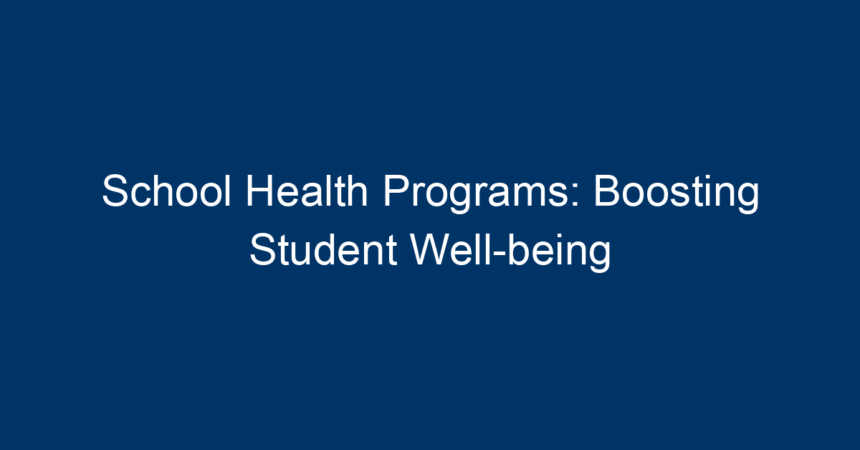In an age where academic pressures are ever-increasing, ensuring the physical and mental well-being of students has become more vital than ever. School health programs are indispensable tools that help cultivate a supportive environment conducive to learning. By focusing on the holistic well-being of students, these programs not only improve academic performance but also set the stage for a healthier future. This article explores the various facets of school health programs and how they contribute to enhanced student well-being.
Understanding School Health Programs
What Are School Health Programs?
School health programs encompass a series of initiatives and activities aimed at promoting the health and well-being of students. These programs are typically administered by schools in collaboration with health organizations and community stakeholders. They cover various aspects of health, including education on healthy eating, physical activity, mental health, substance abuse prevention, and sexual health education.
The Importance of School Health Programs
Investing in school health programs has a far-reaching impact on students’ academic success and overall well-being. By addressing health issues, schools can reduce absenteeism, promote positive behavior, and enhance students’ ability to focus during lessons. Moreover, these programs establish a foundation for lifelong healthy habits, encouraging students to make informed choices about their health.
Key Components of Effective School Health Programs
1. Nutrition Education
A healthy diet is crucial for students’ cognitive and physical development. School health programs often include nutrition education that teaches students the importance of eating well-balanced meals. This includes workshops, cooking classes, and school gardens that promote understanding of where food comes from.
2. Physical Activity Initiatives
Regular physical activity is essential for maintaining physical health and improving mental well-being. Schools encourage physical activity through organized sports, recess, and activities designed to get students moving. Programs may offer different options, catering not just to athletes but also to students who prefer non-competitive activities.
3. Mental Health Support
Mental health is a cornerstone of student well-being. School health programs often integrate mental health support services, including counseling and workshops aimed at building resilience, managing stress, and fostering positive relationships. Providing access to mental health resources ensures that students can seek help when needed.
4. Substance Abuse Prevention
Substance abuse can derail a student’s academic and personal life. School health programs typically include educational content that tackles the risks associated with drugs, alcohol, and tobacco. Interactive sessions and peer discussions create an open dialogue about substance use, helping students make informed decisions.
5. Sexual Health Education
Providing comprehensive sexual health education is critical for preparing students for responsible decision-making. School health programs ensure that students receive age-appropriate information about relationships, consent, and reproduction, contributing to healthier interpersonal relationships.
6. Health Screenings
Regular health screenings can identify potential issues before they escalate. Many school health programs incorporate physical, vision, and hearing screenings. Early detection supports better academic performance and overall health.
Benefits of Implementing School Health Programs
Improved Academic Performance
Focusing on health leads to improved attention, memory, and classroom behavior. Students participating in health programs tend to score higher on tests and have better overall academic outcomes. A healthy student is a productive student.
Reduced Absenteeism
Health-related absences can disrupt a student’s education. School health programs aim to minimize issues like hypertension, obesity, and mental health conditions, leading to fewer missed school days. Consistent attendance is key to academic success.
Enhanced Social Skills
Health programs that promote teamwork and cooperation—such as sports and group projects—can help students develop essential social skills. These skills are important for forming friendships and fostering a positive school climate.
Lifelong Healthy Habits
School health programs lay the groundwork for lifelong healthy behaviors. Students who learn about nutrition, exercise, mental wellness, and healthy relationships are more likely to carry these lessons into adulthood, reducing risks of chronic diseases.
Challenges of Implementing School Health Programs
Funding Issues
Financial constraints can limit the reach of school health programs. Securing funding from local government, health organizations, or grants is essential for expanding and enhancing these programs.
Limited Staff Training
Teachers and school staff need appropriate training to effectively implement school health programs. Ongoing professional development ensures they have the skills and knowledge to deliver impactful health education.
Resistance to Change
Introducing new health programs can face resistance from parents or community members who are skeptical about the need for such programs. Clear communication about the benefits and evidence supporting health programs can help mitigate these concerns.
Actionable Insights for Schools
Engage the Community
Schools should partner with parents, community health organizations, and local businesses to build a supportive network for implementing school health programs. Community engagement fosters shared responsibility for student health.
Regular Assessment
Conducting regular assessments can track the effectiveness of school health programs. Surveys, health screenings, and academic performance metrics provide valuable insights into areas for improvement.
Tailor Programs to Student Needs
Each school has a unique student population with varying needs. Tailoring health programs to these needs — whether addressing specific health issues or cultural considerations — enhances relevance and efficacy.
Advocate for Policy Support
Schools should advocate for policies that support health initiatives at the local and state levels. Collaborating with policymakers ensures that school health programs receive necessary funding and resources over the long term.
Conclusion
Investing in school health programs is an investment in the future — both for students and society as a whole. By prioritizing student well-being, schools can foster an environment where students are not only academically successful but also equipped with the tools and knowledge to lead healthy, fulfilling lives. Parents, educators, and community members must collaborate to create a healthier generation. By implementing effective school health programs, we can address the pressing health challenges of today and pave the way for a healthier tomorrow.
Call to Action
If you are a parent, educator, or community member, advocate for the implementation or enhancement of school health programs in your local schools. Together, we can boost student well-being and create healthier futures for our children.




